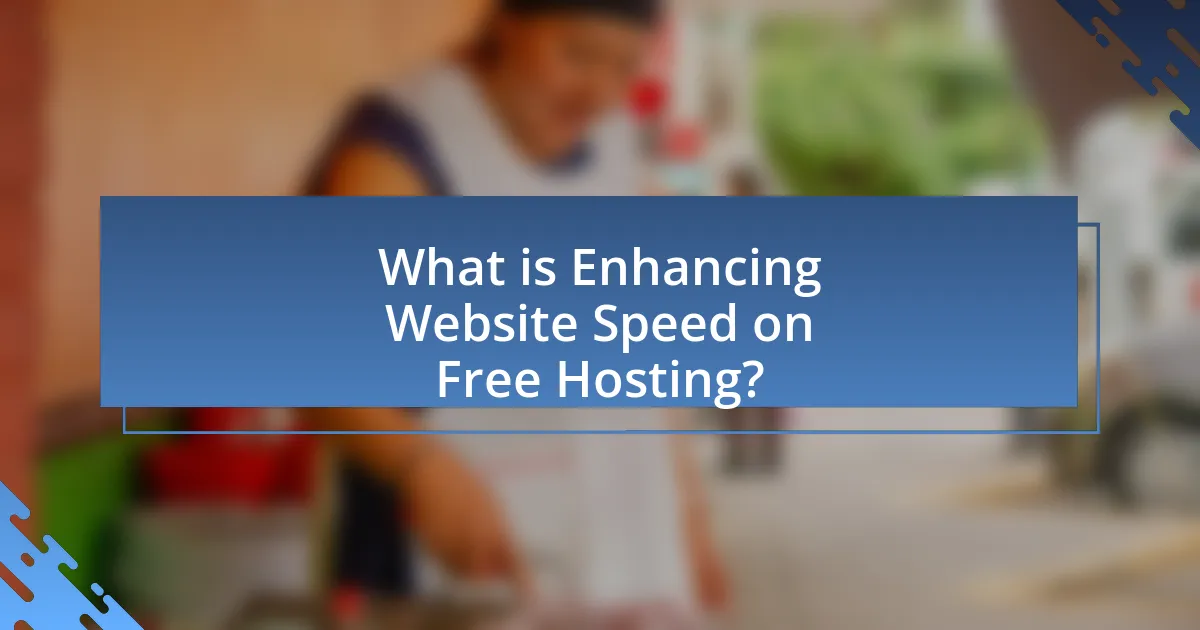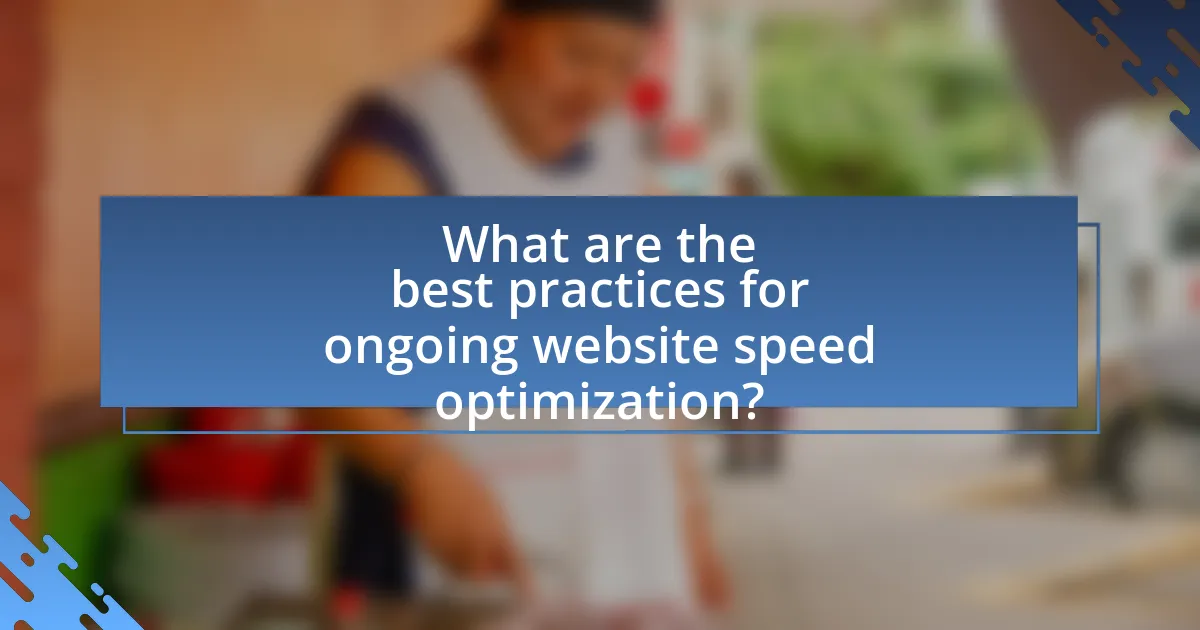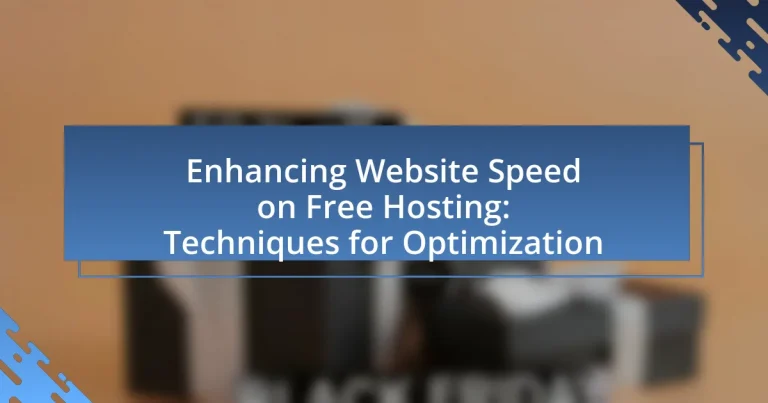Enhancing website speed on free hosting involves optimizing various elements to improve loading times despite the inherent limitations of such services. Key techniques include image optimization, leveraging browser caching, minimizing HTTP requests, and utilizing content delivery networks (CDNs). The article discusses the impact of website speed on user experience and SEO, highlighting critical metrics for measurement and the challenges posed by free hosting services. Additionally, it outlines best practices for ongoing optimization and common mistakes to avoid, providing practical tips to enhance performance effectively.

What is Enhancing Website Speed on Free Hosting?
Enhancing website speed on free hosting involves optimizing various elements of a website to improve loading times despite the limitations of free hosting services. Techniques include minimizing file sizes through compression, utilizing content delivery networks (CDNs) to distribute content efficiently, and optimizing images to reduce their impact on load times. Research indicates that websites that load within two seconds have a significantly lower bounce rate, emphasizing the importance of speed for user retention and engagement.
How does website speed impact user experience?
Website speed significantly impacts user experience by influencing user satisfaction and engagement levels. Faster loading times lead to lower bounce rates, as users are more likely to stay on a site that loads quickly. Research by Google indicates that 53% of mobile users abandon sites that take longer than three seconds to load, highlighting the critical nature of speed in retaining visitors. Additionally, a study by Akamai found that a one-second delay in page load time can result in a 7% reduction in conversions, demonstrating that website speed directly affects business outcomes. Therefore, optimizing website speed is essential for enhancing overall user experience and achieving higher engagement and conversion rates.
What are the key metrics for measuring website speed?
The key metrics for measuring website speed include Page Load Time, Time to First Byte (TTFB), First Contentful Paint (FCP), and Speed Index. Page Load Time measures the total time taken for a webpage to fully load, typically aiming for under three seconds for optimal user experience. Time to First Byte indicates the time taken for the server to respond to a request, with lower values indicating better performance. First Contentful Paint measures the time it takes for the first piece of content to appear on the screen, ideally within one second. Speed Index quantifies how quickly the contents of a page are visibly populated, with lower scores reflecting faster loading times. These metrics are essential for assessing and optimizing website performance, as they directly impact user engagement and satisfaction.
Why is website speed crucial for SEO?
Website speed is crucial for SEO because it directly impacts user experience and search engine rankings. Faster websites lead to lower bounce rates and higher engagement, which are key factors that search engines like Google consider when ranking pages. According to Google, a one-second delay in page load time can result in a 20% decrease in conversions. Additionally, in 2021, Google introduced Core Web Vitals as ranking signals, emphasizing the importance of loading performance, interactivity, and visual stability. Therefore, optimizing website speed is essential for improving both user satisfaction and search visibility.
What challenges do free hosting services present for website speed?
Free hosting services often present significant challenges for website speed due to limited server resources and bandwidth restrictions. These services typically allocate minimal CPU and RAM to each user, resulting in slower processing times and increased loading delays during high traffic periods. Additionally, free hosting providers may impose bandwidth caps, leading to throttling or downtime when a website exceeds its allocated data transfer limits. Research indicates that websites hosted on free platforms can experience load times that are 2 to 3 times slower compared to those on paid hosting services, negatively impacting user experience and search engine rankings.
How do server limitations affect website performance?
Server limitations significantly hinder website performance by restricting resources such as CPU, memory, and bandwidth. When a server has limited CPU power, it can slow down the processing of requests, leading to longer load times for users. Additionally, insufficient memory can cause delays in data retrieval and processing, while limited bandwidth restricts the amount of data that can be transmitted, resulting in slower page loading speeds. According to a study by Google, a one-second delay in loading time can lead to a 20% decrease in conversions, highlighting the critical impact of server limitations on user experience and site effectiveness.
What role does bandwidth play in website speed on free hosting?
Bandwidth directly affects website speed on free hosting by determining the amount of data that can be transmitted to users at any given time. Limited bandwidth can lead to slower loading times, especially during peak traffic periods, as the server struggles to deliver content efficiently. For instance, if a free hosting service allocates only a small bandwidth limit, users may experience delays or timeouts when accessing the website, particularly if multiple visitors are trying to load data simultaneously. This correlation between bandwidth and speed is crucial, as studies have shown that websites with higher bandwidth availability can load significantly faster, enhancing user experience and engagement.

What techniques can be used to enhance website speed on free hosting?
To enhance website speed on free hosting, techniques such as optimizing images, leveraging browser caching, minimizing HTTP requests, and using a Content Delivery Network (CDN) can be employed. Optimizing images reduces their file size without sacrificing quality, which decreases load times. Leveraging browser caching allows frequently accessed resources to be stored locally on users’ devices, speeding up subsequent visits. Minimizing HTTP requests by combining files, such as CSS and JavaScript, reduces the number of requests made to the server, thus improving load speed. Utilizing a CDN distributes content across multiple servers globally, allowing users to access data from the nearest location, which significantly enhances loading times. These techniques are widely recognized in web performance optimization and have been shown to improve user experience and engagement.
How can image optimization improve website loading times?
Image optimization can significantly improve website loading times by reducing the file size of images without compromising quality. When images are optimized, they consume less bandwidth and load faster, which enhances the overall user experience. Studies show that optimized images can reduce page load times by up to 80%, leading to lower bounce rates and higher engagement. For instance, a report by Google indicates that a one-second delay in loading time can result in a 20% decrease in conversions. Therefore, effective image optimization is crucial for improving website performance and user satisfaction.
What tools are available for compressing images?
Tools available for compressing images include TinyPNG, JPEGmini, ImageOptim, and Optimizilla. These tools effectively reduce image file sizes while maintaining quality, which is crucial for enhancing website speed. For instance, TinyPNG uses smart lossy compression techniques to decrease the file size of PNG and JPEG images by up to 70% without noticeable loss in quality. JPEGmini claims to reduce JPEG file sizes by up to 80% while preserving the original image quality. ImageOptim is popular among Mac users for its ability to compress images in bulk, and Optimizilla allows users to adjust the compression level for optimal results. These tools are widely recognized for their effectiveness in optimizing images for faster website loading times.
How does choosing the right image format affect speed?
Choosing the right image format significantly affects website speed by influencing file size and loading times. For instance, formats like JPEG and PNG have different compression methods; JPEG is typically smaller for photographs due to lossy compression, while PNG is better for images requiring transparency but often results in larger file sizes. A study by Google found that using WebP format can reduce image sizes by up to 30% compared to JPEG and PNG without sacrificing quality, leading to faster loading times. Consequently, selecting an appropriate image format can enhance overall website performance, particularly on free hosting platforms where bandwidth may be limited.
What is the significance of minimizing HTTP requests?
Minimizing HTTP requests is significant because it directly enhances website speed and performance. Each HTTP request requires time for the server to respond, and reducing the number of requests decreases load times, leading to a better user experience. Studies show that a one-second delay in page load time can lead to a 7% reduction in conversions, highlighting the importance of optimizing request counts for improved site efficiency. Additionally, fewer requests can lower server load and bandwidth usage, which is particularly beneficial for websites hosted on free services with limited resources.
How can combining files reduce loading times?
Combining files reduces loading times by minimizing the number of HTTP requests a browser must make to load a webpage. When multiple files, such as CSS and JavaScript, are combined into a single file, the browser can retrieve that file in one request instead of multiple requests for each individual file. This reduction in requests decreases the overall load time, as each request incurs latency due to network delays. Studies have shown that reducing HTTP requests can lead to significant performance improvements; for instance, a reduction from 20 requests to 5 can improve loading times by up to 50%.
What are the best practices for using CSS and JavaScript?
The best practices for using CSS and JavaScript include minimizing file sizes, using asynchronous loading, and optimizing selectors. Minimizing file sizes can be achieved through techniques such as minification and compression, which reduce the amount of data transferred, thereby enhancing loading speed. Asynchronous loading allows scripts to load without blocking the rendering of the page, improving user experience and perceived performance. Optimizing selectors ensures that CSS rules are applied efficiently, which can significantly reduce rendering time. According to Google’s Web Fundamentals, following these practices can lead to faster page load times and improved overall performance, which is crucial for websites hosted on free platforms with limited resources.

What are the best practices for ongoing website speed optimization?
The best practices for ongoing website speed optimization include regularly monitoring website performance, optimizing images, leveraging browser caching, minimizing HTTP requests, and utilizing a Content Delivery Network (CDN). Regular performance monitoring allows for the identification of speed issues, while optimizing images reduces file sizes without sacrificing quality, which can significantly enhance load times. Leveraging browser caching enables faster retrieval of resources by storing them locally on users’ devices, thus decreasing load times for repeat visitors. Minimizing HTTP requests by combining files and reducing the number of elements on a page can also lead to faster loading. Finally, utilizing a CDN distributes content across multiple servers globally, reducing latency and improving access speed for users regardless of their location. These practices are supported by studies indicating that a one-second delay in page load time can lead to a 7% reduction in conversions, highlighting the importance of speed optimization for user experience and business outcomes.
How can regular performance testing help maintain speed?
Regular performance testing helps maintain speed by identifying bottlenecks and inefficiencies in a website’s functionality. By conducting tests at consistent intervals, developers can monitor load times, response times, and resource usage, allowing them to pinpoint areas that require optimization. For instance, a study by Google found that a one-second delay in mobile load times can reduce conversions by up to 20%. This data underscores the importance of regular testing, as it enables timely adjustments to improve user experience and maintain optimal speed.
What tools can be used for website speed testing?
Tools that can be used for website speed testing include Google PageSpeed Insights, GTmetrix, Pingdom, and WebPageTest. Google PageSpeed Insights analyzes the content of a web page and provides suggestions to make that page faster, while GTmetrix combines Google PageSpeed and YSlow metrics to give a comprehensive overview of performance. Pingdom offers real-time monitoring and performance insights, and WebPageTest allows users to test their site from multiple locations and browsers. These tools are widely recognized for their effectiveness in measuring and improving website speed.
How often should website speed tests be conducted?
Website speed tests should be conducted at least once a month. Regular testing helps identify performance issues that may arise due to changes in website content, updates, or increased traffic. According to Google, page speed is a ranking factor, and slow-loading pages can lead to higher bounce rates, negatively impacting user experience and SEO. Therefore, monthly assessments ensure that any speed-related problems are promptly addressed, maintaining optimal performance.
What common mistakes should be avoided in speed optimization?
Common mistakes to avoid in speed optimization include neglecting image optimization, failing to leverage browser caching, and not minifying CSS and JavaScript files. Neglecting image optimization can lead to unnecessarily large file sizes, which slow down page load times; for instance, unoptimized images can account for up to 60% of a webpage’s total weight. Failing to leverage browser caching prevents returning visitors from loading pages faster, as they must download all resources again. Not minifying CSS and JavaScript files increases the amount of data that needs to be transferred, which can significantly impact loading speed; studies show that minification can reduce file sizes by up to 30%.
How can excessive plugins slow down a website?
Excessive plugins can slow down a website by increasing the number of HTTP requests and consuming server resources. Each plugin typically requires its own scripts and styles, which can lead to longer loading times as the server processes multiple requests. Additionally, poorly coded plugins can introduce inefficiencies, causing higher CPU and memory usage, which further degrades performance. Research indicates that websites with more than 20 plugins can experience significant slowdowns, with load times increasing by up to 50% compared to those with fewer plugins.
What are the risks of neglecting mobile optimization?
Neglecting mobile optimization can lead to significant risks, including decreased user engagement and higher bounce rates. Research indicates that 53% of mobile users abandon sites that take longer than three seconds to load, highlighting the importance of speed and usability on mobile devices. Additionally, poor mobile optimization can negatively impact search engine rankings, as Google prioritizes mobile-friendly websites in its search results. This can result in reduced visibility and traffic, ultimately affecting conversion rates and revenue. Furthermore, a lack of mobile optimization can damage brand reputation, as users may perceive a website that is not mobile-friendly as outdated or unprofessional.
What practical tips can enhance website speed on free hosting?
To enhance website speed on free hosting, optimize images by compressing them to reduce file size without sacrificing quality. This practice is crucial because large images can significantly slow down loading times; for instance, unoptimized images can account for up to 60% of a webpage’s total weight. Additionally, utilize browser caching to store frequently accessed resources locally, which can decrease load times for returning visitors. Implementing a Content Delivery Network (CDN) can also improve speed by distributing content across multiple servers closer to users, thus reducing latency. Furthermore, minimize HTTP requests by combining CSS and JavaScript files, which streamlines the loading process. These strategies collectively contribute to a more efficient website performance on free hosting platforms.
How can caching improve website performance?
Caching can significantly improve website performance by storing frequently accessed data temporarily, which reduces the time needed to retrieve that data from the original source. When a user requests a webpage, caching allows the server to deliver the stored version of the page instead of generating it anew, leading to faster load times. For instance, studies show that websites utilizing caching can experience load time reductions of up to 70%, enhancing user experience and engagement. Additionally, caching decreases server load, allowing for better resource allocation and improved scalability during high traffic periods.
What role does content delivery network (CDN) play in speed optimization?
A content delivery network (CDN) significantly enhances speed optimization by distributing content across multiple geographically dispersed servers. This distribution reduces latency, as users access data from the nearest server, resulting in faster load times. For instance, a study by Akamai found that a 100-millisecond delay in load time can decrease conversion rates by 7%. By caching static content and optimizing delivery routes, CDNs ensure that websites load quickly, even during high traffic periods, thereby improving overall user experience and engagement.


